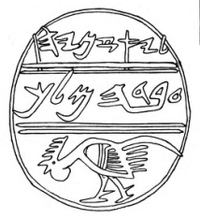Jaazaniah
Jaazaniah (Hebrew: יַאֲזַנְיָה Yaʾăzanyā, lit. “May God hear”) or Jezaniah is a biblical Hebrew personal name that appears in the Bible for several different individuals, and has been found on an onyx seal dating from the 6th century BCE.
Biblical references

Four distinct individuals named Jaazaniah are mentioned in the Bible:
Jaazaniah the son of Hoshaiah was an officer in the army of the kingdom of Judah. He joined the Babylonian-appointed ruler Gedaliah at Mizpah after the exile of Judah (2 Kings 25:23 and Jeremiah 40:8). He was also called Jezaniah.[1] The onyx seal found at Mizpah dating to this period and bearing the inscription “(belonging) to Ya’azaniah the servant of the king” may have belonged to this individual.[2][3]
Jaazaniah, son of a man called Jeremiah (not the prophet), and grandson of Habazziniah, was the leader of the clan of the
Jaazaniah son of Shaphan was one of the 70 elders of Israel whom the prophet
Jaazaniah son of Azzur was a leader of Israel and a false prophet whom the prophet Ezekiel sees in a vision of iniquitous elders standing at a gate of the Temple, falsely telling the people that Jerusalem will not be destroyed (
Onyx seal

The name Jaazaniah appears on a sixth-century BC
The seal carries the inscription “(belonging) to Jaazaniah the servant of the king.” The seal may have belonged to an officer named Jaazaniah who, according to II Kings 25:23 and Jeremiah 40:8, came to the Babylonian-appointed ruler Gedaliah at Mizpah after the fall of Jerusalem.[2][3]
At the bottom of the seal is the image of a
See also
- List of artifacts significant to the Bible
References
- ^ ISBN 978-0-8276-0863-4.
- ^ a b c d Zorn, Jeffrey R. (Jul–Aug 1997). "Mizpah: Newly Discovered Stratum Reveals Judah's Other Capital". Biblical Archaeology Review. 23 (5): 69–71.
- ^ S2CID 170217508.
- ^ a b "Tell en-Nasbeh: Biblical Mizpah of Benjamin". The College of Arts and Sciences, Cornell University.
- ^ A. Reifenberg, Ancient Hebrew Seals, 1948, page 36
- ISBN 0-664-21262-X.
- .
- ISBN 1-58983-042-3.
